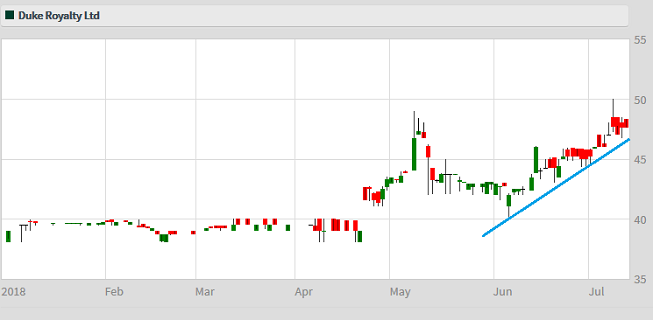Stockwatch: An AIM share with potential for double-digit yield
17th July 2018 10:33
by Edmond Jackson from interactive investor
This high-yielding small-cap makes money from a near-exclusive concept and could have plenty of mileage, argues Edmond Jackson.

With AIM-listed shares of Duke Royalty at around 49p, this £48 million royalty investment company is enjoying renewed interest from buyers, its price near the top of a circa 38p to 50p range since 2016.
There's potentially a break-out here after Duke has announced a £44 million equity capital raising "to continue to finance its diversified pipeline of royalty financing opportunities".
I like the royalty concept – owning a percentage of investee company revenues, as if in between equity and debt financing – although the only such listed vehicle until Duke has been £250 million Anglo Pacific Group which focuses on mining royalties – especially coal. Thus, you are mainly trying to judge whether the commodities cycle is attractive, with coal notoriously volatile.
A relatively novel concept for investment income
On the face of it, Duke has yet to prove consistency, given its chart shows a plunge from 300p in 2014 and the table a steep drop in net tangible assets per share. However, the company was re-vamped exactly three years ago – a change in name from Praetorian Resources, and investment activity towards royalties than equity or debt.
In March 2017, £15 million was raised at 40p a share to start the ball rolling: "The directors believe there is a substantial addressable market for royalty finance...with potential to generate attractive returns uncorrelated to general equity market performance", this on a truly long-term basis of 25 to 40 years per royalty, even in perpetuity.
The business model involves each investee typically paying Duke a monthly royalty amounting to 12-15% annually, of the financing amount, during the first year. Thereafter, monthly distribution is linked to annual revenue growth, the attraction to investees being long-term finance at lower cost of capital than equity, without dilution or loss of control.

Source: interactive investor Past performance is not a guide to future performance
Highly focused portfolio to date
Royalties ought to have potential beyond the mining sector where it originated, generating useful returns without the inherent volatility of commodities. Obviously, much depends on management capability to pick the right companies.
Over the last 16 months, Duke has accumulated as yet just four royalty investments: Temarca, a 20 year-old Dutch river cruising firm; Lynx Equity, a mini-conglomerate; Trimite Global Coatings, a Birmingham-based industrial paint specialist founded in the 1940s; and Brownhills Investments which owns one of the UK's leading independent glass merchants and processors.
The current £42 million (net) placing is to fund a further four royalty situations totaling £27.5 million, and provide additional capital to three existing investments.
Near double-digit yield potential from well-established firms
"Upon full capital deployment, the board believes that Duke will be able to increase the company’s dividend to a near double-digit yield." Mind, this would still be a highly-focused portfolio and the yield assumption is likely based on the 44p issue price, buyers around the 50p level should still do well – barring an economic slump compromising any company in the portfolio before it better diversifies.
Duke proposes putting £10 million into a 24 year-old provider of clinical management services with 25-30 year contracts managing hospitals in a variety of countries; up to £5.3 million equivalent into a leading US publisher – since the 1950s - focused on changes in police law; £6.8 million equivalent into a 19 year-old US health foods company expanding its estate of 6,000 vending machines across 40 states; and £4.4 million into a 28 year-old European manufacturer of patented noise and vibration detectors.
Long-term proof of commercial calibre mitigates risk with a focused approach, although the flip-side is these businesses implicitly not self-funding (from internal cash flow) as to growth. If any such deal doesn’t conclude, there’s said to be a pipeline of further opportunities.
Yet to announce annual results but dividend rises
Duke's board indicated the interim dividend would rise by 0.1p to 0.7p per quarter, and the 2019 year forecast (see table) is for 2.8p per share, which ought to be proof of cash flow despite a lack of accounts until prelims due early September. Thus, a prospective yield of 5.7% at the current market price, or 6.4% at the placement price, implies the board is well-confident to target a double-digit yield in due course.
In addition to 100 million new shares being issued (96.8% allocated to a placing, with no detail about whether private client brokers may be involved). Just over another million will be issued for an incentive plan, implying dilution over 104% which may pose a question over the 3.1p earnings per share target for the year to March 2019, given a 14 June 2018 date on the company broker’s forecasts.
A price/earnings (PE) multiple possibly in the twenties than mid-teens, can look high relative to the intrinsic returns from royalties, but if a sound dividend record establishes then it should support the stock.
Moreover, last September's interim balance sheet had net assets of £14.6 million, mainly royalty debt instruments and cash, implying net assets per share of 32p, which may not be impacted by impending dilution, given the placing will feed straight through to royalties/cash.
Yes, the stock likely trades at a premium to net asset value, but the market is likely to sustain one so long as Duke's news-flow of deals and their performance avoids glitches.
Thus, for a stock yielding 5%-plus, the long-term prospect also for assets and earnings growth – if Duke can carve out a status as a rather unique financier – beckons. The stock may still have tight liquidity come the next economic downturn, which will be its true test, but Duke looks net attractive for investors who appreciate such risks.
£26.8 million retained losses on balance sheet
This is interesting if future profits can be sheltered against tax, although Duke is anyway based in Guernsey which may be for corporate as well as employee tax advantages. I noted the same thing for AIM-listed litigation finance specialist Burford Capital in its early years, which has a Guernsey domicile for its international operations.
Duke's losses derive from a string of professional fees totalling - over £600,000 in its last two, first-half financial years, versus just over £400,000 investment gain in H1 2018 year plus a £100,000 foreign currency gain. So it’s too early to see any effect of retained losses on taxation and the income statement.
Not to invite close comparison with Burford, which has much the racier risk/reward profile and profits leverage, but Duke is similar in terms of a business with international perspective, led by a Canadian chief executive (versus Burford’s North American), choosing to list on AIM.
Cynics would say AIM means you should only "invest" money you can afford to lose, yet both companies take risk management seriously, and Duke's niche of royalty financing could have plenty of mileage. Speculative buy.
| Duke Royalty Limited - financial summary | Consensus estimates | |||||||
|---|---|---|---|---|---|---|---|---|
| year ended 31 Mar | 2014 | 2015 | 2016 | 2017 | 2018 | 2019 | ||
| Turnover (£ million) | -4.9 | -2.4 | ||||||
| IFRS3 pre-tax profit (£m) | -5.7 | -6.9 | -4.1 | -1.4 | ||||
| Normalised pre-tax profit (£m) | -5.7 | -6.9 | -3.9 | -1.3 | 0.4 | 3.4 | ||
| IFRS3 earnings/share (p) | -4,614 | -303 | -65.0 | -16.0 | ||||
| Normalised earnings/share (p) | -4,608 | -303 | -62.6 | -14.5 | 1.6 | 3.1 | ||
| Price/earnings multiple (x) | 30.6 | 15.8 | ||||||
| Historic annual average P/E (x) | 26.7 | |||||||
| Cash flow/share (p) | -766 | 15.7 | 1.3 | -8.7 | ||||
| Dividend per share (p) | 2.1 | 2.8 | ||||||
| Dividend yield (%) | 4.3 | 5.7 | ||||||
| Covered by earnings (x) | 0.8 | 1.1 | ||||||
| Net tangible assets per share (p) | 416 | 137 | 26.3 | 32.0 | ||||
| Source: Company REFS |
Edmond Jackson is a freelance contributor and not a direct employee of interactive investor.
These articles are provided for information purposes only. Occasionally, an opinion about whether to buy or sell a specific investment may be provided by third parties. The content is not intended to be a personal recommendation to buy or sell any financial instrument or product, or to adopt any investment strategy as it is not provided based on an assessment of your investing knowledge and experience, your financial situation or your investment objectives. The value of your investments, and the income derived from them, may go down as well as up. You may not get back all the money that you invest. The investments referred to in this article may not be suitable for all investors, and if in doubt, an investor should seek advice from a qualified investment adviser.
Full performance can be found on the company or index summary page on the interactive investor website. Simply click on the company's or index name highlighted in the article.